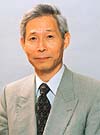 |
 Looking
back at the Development of ISDB Looking
back at the Development of ISDBTakehiko YOSHINO, Managing Director, NHK December 1, 2000 marked the commencement of digital satellite broadcasting services by NHK and other commercial broadcasters in Japan. NHK has been promoting research and development in this field for many years, and now ISDB (Integrated Services Digital Broadcasting) has been realized for the first time. Creating the ISDB Concept The concept of ISDB involves the broadcasting of all kinds of information in a digital format, not only video and sound data, but also still pictures, textual data, diagrams and so on. This will bring about a new broadcasting style that transcends conventional TV services. This concept, created in the summer of 1982, was initially dubbed the "digital highway." It was then adopted in a report, "Long-Range Prospects for the Use of Radio Waves", compiled by the Ministry of Posts and Telecommunications (MPT) in June 1984. It was next proposed to the CCIR (currently ITU) as a study program and approved as such in 1985. The MPT report states, regarding ISDB: "In terms of the ultimate goal of making broadcasting systems wholly digital, any system which can integrate all kinds of information is considered desirable from the viewpoint of realizing the efficient use of radio waves as well as providing a variety of services. One of the possibilities is an ISDB utilizing a broadband channel for digital broadcasting. This would enable flexible broadcasting operations, in which various services, including sound, television, data, and high-definition TV broadcasting, can be combined and transmitted through the digital transmission channel." This indeed reads as a bold proposal, even to all of us as we review it now. However, this proposal did not attract much attention at that time. The reason was due to the fact that video compression technology back then was still at the level where only a single SDTV program could be transmitted on the 27MHz channel of a 12GHz broadcasting satellite. It seemed that full-scale ISDB still have to wait until a 21GHz-band satellite became available, enabling the utilization of a channel with a broader band. Never Giving up the Dream It seems that the proposal, which we had made so confidently, had "swung wide," but we did not lose our zeal. Research on ISDB proceeded under various projects, such as multi-channel PCM sound broadcasting, Hi-Vision audio graphics, and multiplexed data broadcasting. In the 1990s, ISDB finally began to draw attention. In order to accelerate ISDB-related research, we established a special project team in 1993. The purpose of this was to make a thorough examination with regard to what ISDB could realize and how broadcasting would be transformed in the future. Results from this effort were presented in a brochure and a Hi-Vision program, "Future Television 201X." Breakthrough It is a very emotional thing for me now to see how most of the services proposed in the program, "201X", are now technically feasible and some are already being provided by digital BS broadcasting in Japan. The forces that drove these advances in the technological field were the MPEG-2 video compression and IC technology, including the progress of microprocessors and memory devices. To make the best use of the ISDB concept, it was also necessary to secure adequate transmission capacity. We developed the Trellis-coded 8 PSK modulation scheme to accomplish this. The combination of this scheme with MPEG-2 video compression made it possible to broadcast two Hi-Vision programs on a single BS channel. Realization of the Dream Once it was decided in 1997 to commence digital broadcasting during the year 2000, the standardization of the broadcasting system advanced quickly in Japan. The intense round-the-clock efforts made by the young researchers and engineers to prepare the new broadcasting system for the December 2000 goal achieved the first step toward realizing the dreams described in "Future Television 201X." |
Copyright 2000 NHK (Japan Broadcasting Corporation) All rights reserved. Unauthorized copy of the pages is prohibited.
 |
 |
| NHK STRL | NHK Broadcast Technology |